
ALTAR GUILD ONLINE
Almighty God, our Heavenly Father, you have desired to be worshipped in spirit and truth, and in the beauty of holiness: I humbly ask you to fill me with your bountiful Spirit and bless the work of my hands and the thoughts of my heart; that I may serve you in holiness as I prepare your Altar for worship; that the congregation may know you through your Word and Sacraments; and may your Name be exalted in this place; through Jesus Christ, my Savior and Lord. Amen.

This manual can be downloaded in print form here. See the topics to the left to access information in specific areas.
- Mission
- Responsibilities
- Altar Table
- Baptism
- Wedding
- Funeral
- After the Services
- Altar Linens
- Sacred Vessels
- Vestments
- Candles
- Flowers
- Seasons and Colors
- Symbols
- Liturgical space
- The Sacristy
- Resources
- Common Terms
From the Bishop
If you are using this Altar Guild Online Manual, I would like to thank you for your willingness to serve our Lord by assisting the clergy in preparing for the worship of Almighty God. I cannot thank enough all of the faithful Altar Guild members who have helped me throughout the years!!! Their faithful service has not only eased my load as a priest, but blessed countless lives with their behind the scenes service of the Lord. May your service do the same.This Altar Guild Manual Online is meant to be a guide and a help for those seeking to properly prepare the Altar and Altar Table for various aspects of Anglican worship. It is not all-inclusive and care should be taken to follow the guidance of your own clergy in these areas. We are not liturgical legalists so please use what is appropriate in your setting and in your congregational tradition. This guide is meant to help things be done properly and good order (1 Corinthians 14:40) and in the beauty of holiness (Psalm 96:9).May you be blessed and know the Presence of the Lord as you serve at His Altar!
Your Brother in Christ,
Bishop Beach
July 2013
A Preface
As members of the Lay Advisory Board of the American Anglican Council (AAC), as congregants of parishes within the Anglican Diocese of the South (ADOTS), and as Altar Guild members, we have endeavored to provide a basic Manual as a guide or template for use by Altar Guild members from our diocese and from other dioceses. May it prove helpful.
Over two years ago, The Rt. Rev. Dr. Foley Beach, Bishop of the Anglican Diocese of the South, made his now longstanding request for a Diocesan Altar Guild Manual. The Bishop’s request, coupled with the AAC Lay Advisory Board’s designation of an Altar Guild Manual as one of several resources it could potentially provide to Anglican parishes and dioceses, brought this document finally to fruition.
Many parishes within ADOTS and within the Anglican Church in North America (ACNA) are “starting over” in one way or another. Some parish families do not have their own church buildings anymore. Others are new church plants. By the Grace of God these parishes are growing and blooming. This Altar Guild Manual is designed to assist them in maintaining an historic Anglican tradition, and to serve as a practical guide within the variety of worship styles and situations found currently in many churches.
“Lord, I love the house in which you dwell and the place where your glory abides.”
June 2013
Mrs. Susan Burkart
Mrs. Gail Kelly
Mrs. Janet Smiley
—
Altar Guild Mission, Purpose, and Membership
The Altar Guild is a lay ministry to serve God in His house by preparing the Sanctuary for worship, maintaining and caring for the sacred vessels, altar linens, and vestments, and serving the clergy and the parish. Prior to the nineteenth century, these duties were performed by the clergy and later by the sacristan or parish clerk. By the late nineteenth century, the altar guild had come into being.
The Rector (or Vicar) is the head of the altar guild, which functions under his guidance and direction. The rector appoints the director of the altar guild and its members.
Altar Guild members should be congregants confirmed in the Anglican Church and should view their service as a sacred duty.
As written so beautifully by Josephine Smith Wood in her Altar Guild Manual, 1915, “Before entering upon work about the Altar, kneel a few moments at the Chancel rail, and, offering your work to God, ask Him to accept and bless it, and enable you to do it worthily as unto Him. It is a great honor and privilege to be allowed to care for the holy things in God’s house, and a devout spirit and reverent demeanor should characterize those who are thus engaged.”
—
Altar Guild Training, Responsibilities, Tasks
Altar guild members should receive instruction in ‘setting up’ for services, removal and cleansing of vessels and linens after the services, names of all the vessels, linens and vestments used in the church, liturgical colors and seasons, use of flowers, use of candles, church symbols, and parts of the church.
In most Anglican churches, altar guild duties include:
1. Making sure that the Sanctuary is dusted and cleaned thoroughly before and after services.
2. Placement of proper seasonal colors, hangings and falls.
3. Preparation of the Altar Table for services.
4. Preparation of the Credence Table/Shelf.
5. Arrangement and placement of fresh flowers (some churches have a flower guild for this).
6. Placement of the candles on the Altar Table and within the Sanctuary.
7. Ensuring that the priest’s vestments are cleaned, pressed and hanging in the Sacristy.
8. Care, preparation, cleansing, and storing of all the sacred vessels, linens, hangings, and candles.
—
The Altar Table
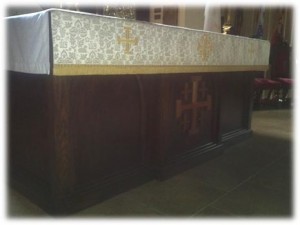
The Altar Table is placed in the center of the Sanctuary, and is where Holy Communion is celebrated. This Table is taller than an ordinary table and should be freestanding. The height should be between 36 and 40 inches and deep and long enough to allow the celebrant(s) to officiate. The top of the Table is called the mensa and often it has 5 crosses etched in it, one on each corner and one in the center. These crosses symbolize the 5 wounds in the body of Christ. The Altar Table, whether stone or wood, should be of the finest workmanship the parish can provide. As always, for temporary spaces and emergencies, a simple table will suffice.
Preparing the Altar Table for Holy Eucharist
Do your service, reverently and when the Nave is empty. Complete your service at least 30 minutes before the worship service begins.
- Make sure Sanctuary is clean.
- Place the Fair Linen on the Altar Table.
- Pay attention to the liturgical color of the Altar Frontal, lectern and pulpit hangings. Change them if they are not the proper color for the service. Refer to the Ordo Calendar and/or the “Seasons and Liturgical Colors” section of this manual.
A. Vesting the Chalice
Depending on your Rector’s preference, the chalice and paten need to be placed on the Altar Table in a reverent manner. For those who do not vest the Chalice and Paten with a burse and veil, follow Steps 1-5. For those who do vest the Chalice and Paten follow steps 1-7. It should be noted that in some Anglican parishes this is placed on the Credence Table and moved to the Altar Table at the time of the offerings. This is up the Rector and his preferences.
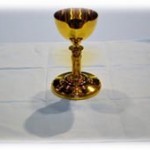
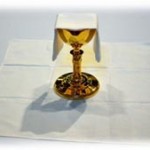

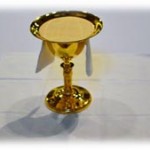
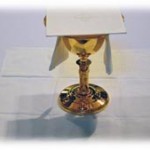
Step 1
Open the folded Corporal and center it on the Altar at the edge of the Fair Linen, with the embroidered cross toward the priest. Place the Chalice in the center of the Corporal.
Step 2
Place the middle third of a folded Purificator over the Chalice, with the end thirds hanging over each side of the Chalice.
Step 3
Place the Paten over the Purificator.
Step 4
Place the Priest’s Host (large wafer) in the Paten.
Step 5
Place the Pall over the Host and Paten.

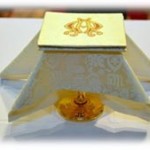
If a Burse and Veil are used
Step 6
Place the Veil over the Pall, so that the front and back edges touch the Altar Table.
Step 7
Place the Burse on top of the Veiled Chalice, with opening facing the Celebrant.
B. Other Items on the Altar Table
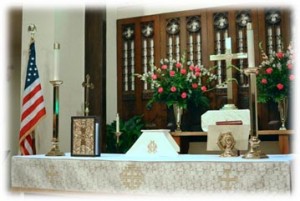
Two Eucharistic or Altar Candles should be placed on the Altar Table, one on either end.
The Missal (Service Book) and Missal Stand should also be placed on the Altar Table. (See Prepared Altar Table)
Prepared Altar Table
The Vested Chalice, two Eucharistic Candles, and the Missal/Missal Stand are the elements present on the Altar Table during Holy Eucharist.
C. Preparing the Credence Table

- Cover the Credence Table/Credence Shelf with a “Credence Cloth”.
- Place two Cruets (glass , silver, etc.), one water (left) and one wine (right), on the Credence Table, right rear.
- Place the Ciborium or Bread Box, filled with appropriate number of wafers, center right front.
- Place the Lavabo Bowl at the left front. The Lavabo Towel is placed across the bowl itself or on the Credence Table next to the Lavabo Bowl.
- Place the Alms Basin or Alms Bag on a shelf underneath the Credence Table/Shelf; alternatively, place it on a small table or stool nearby, not on the Altar Table.
- A Flagon filled with extra wine may also be placed on the Credence Table, as needed.
Reserved elements (blessed wine and bread) may be placed in an Aumbry in order to take Holy Communion to those in the hospital or those unable to attend church for other physical or mental illness.
Credence Table or Shelf Figure
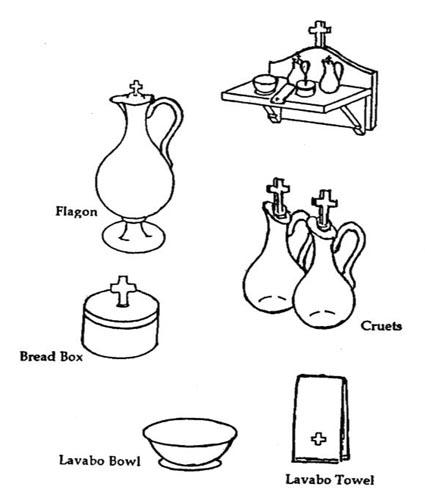
—
Baptism

Font: if possible it should be placed near the entrance to the Nave symbolizing entrance into the Body of Christ, the Church. Remove the top of the font and set it aside or in the Sacristy. Place a small table near the font. Cover the table with credence cloth.
Shell: the silver scallop shaped shell (or a pyx, if the priest prefers) is used to pour water on the candidate’s head. Place the shell on the edge of the font. If the font does not have a ledge it may be placed on the table. If the church does not have a shell, the priest may use his hand to pour water.
Towel: the baptismal towel should be placed over the edge of the font near the shell or on the small table if necessary.
Ewer: this water pitcher is usually made of silver and should be filled less than ½ full with warm water.
Paschal Candle: the Paschal Candle should be lighted and placed nearby.
The priest may ask that the Baptism Certificate and that BCPs marked at Holy Baptism are placed nearby. The liturgical color is white.
—
Wedding
Altar Guild members should place white flowers in their customary location, usually the retable. The wedding kneeler, if used, should be placed before the Altar. If there is no Eucharist, use Altar Candles. The priest decides if decorations may be used in the sanctuary and/or in the nave and Altar Guild members arrange them. If there is to be a communion, set up the Altar Table as usual for a communion service; however leave room on the Table for the blessing of the rings. Traditionally, there are usually no weddings scheduled during Advent or Lent, but this is left to the discretion of the priest. The linens and hangings are white.
—
Funeral
Funerals are very sensitive times for families so special care should be taken to follow the guidance of the priest. Flowers may be placed in the church’s vases and placed on the retable or customary location. The Paschal candle should be used when a body or ashes are present. It is customary that the funeral pall be used on all caskets for services in the church. The funeral pall is placed on the back pew by altar guild members. The Altar Guild members shall meet the coffin at the front doors of the church and assist in placing the pall over the coffin making sure the pall is centered and even on all sides. Some churches have a cremains repository which will be covered with a cremations pall and placed near the chancel steps. The priest will place and remove the ashes from the repository. If the church has a funeral bell, designate an altar guild member to let it “toll” for five to ten minutes after the service. The linens and hangings are white.
After any special service, the liturgical hangings are all changed back to the color of the season. The sanctuary and nave are readied for the next service. The flowers, unless they are to be used for the next service, are taken to the sick, home bound or the bereaved, in the case of funerals. The communion vessels, linens, wedding kneeler, special candles, funeral pall, etc are removed to the sacristy for appropriate care and storage.
—
After the Services
Wait until the Sanctuary, Chancel, and Nave are empty of congregants before removing the Vessels and Altar Linens to the Sacristy for cleansing. In His service, this should be done quietly and reverently.
The Liturgical Rinse
The Chalice, Paten, the corporal, the purificator, and post communion veil and all consecrated elements should be rinsed and this “rinse water” should go directly into the earth. These items are treated reverently because they contain “blessed” or “consecrated” bread and wine.
The Piscina
The sacristy of traditional Anglican churches includes a piscina, a special sink with a drain that goes into the ground rather than into the sewer system. All consecrated elements to be discarded should be poured into the piscina or into the earth, including wine in chalices, wine rinsed from purificators, wafer crumbs from the paten, holy water, sacred oils, blessed ashes, and baptismal water from the font.If there is a piscina with a water faucet/drain combination, rinse the vessels and the altar linens directly into the piscina. Otherwise, a special basin should be kept for the liturgical rinse and the water collected in the basin from the rinse should be poured into the picina or into the ground.If there are no facilities to further cleanse and launder the linens at the church, then it is perfectly acceptable for the Altar Guild member responsible for cleansing the linens to take them home, perform the liturgical rinse into a special basin and pour the water into the earth outside the home before beginning the laundering process.
Cleansing after the Liturgical Rinse
Chalice
The cup of the chalice should be washed in extremely hot soapy water and rinsed in clean extremely hot water, paying special attention to cleaning the rim or lip of the chalice. To prevent water from getting into the stem, avoid immersing it under the water. Dry and buff the chalice with a clean, soft, dry cloth. Store in a soft flannel or tarnish proof bag.
Paten, Lavabo, Ciborium/Breadbox, Flagon and other Vessels
Wash in hot soapy water, rinse in clean hot water. Dry and buff with a clean, soft, dry cloth. Store in soft flannel or tarnish proof bags.
Polish only as necessary. Use a good quality silver polish, and then wash in hot soapy water, dry, and buff. The silver vessels should be polished only 2 or 3 times a year, using a good silver polish. Do not over polish. In between polishing episodes, wash in hot soapy water, dry, and buff with a soft rag to shine and remove fingerprints
Glass Cruets
Pour remaining water from the water cruet down the piscina. If there is any consecrated wine in the wine cruet, place it in the Aumbry for use later. Then rinse both cruets with very hot water and drain. If needed, add either a little vinegar, bleach, ammonia, or denture tablets to the cruets, shake around, and rinse thoroughly several times with clean very hot water.
Linens
Any stained linen or linen which is not fresh appearing should be laundered. After the liturgical rinse, whether washed in the sacristy or in the home of the assigned altar guild member, the stains should be treated and the linens should be put into soak as soon as possible; soak at least 30-60 minutes. Hand wash in hot water using a mild laundry soap and rinse thoroughly. Never put these linens in a dryer. Iron, wrong side up, while the linens are very damp. Never use starch. Avoid tugging on or stretching the fabric while ironing it. Folding should begin after the linens are mostly dry and the ironing has been completed. The work of caring for the altar linens is to be done solely by altar guild members.
—
All about the Altar Linens
All worn out altar linens should be burned and the ashes poured into the picina or buried in the earth.
Altar linens should be made from good quality linen. Nowadays such linen is fairly easy to maintain. All of the altar linens have a cross or other liturgical symbols embroidered on them. These linens may be purchased (see Resources and Supplies) or the talented seamstresses among you may want to make and embroider the altar linens themselves.
When making altar linen, always wash and iron the linen first, to avoid shrinkage, before measuring and cutting it. Fine pure cotton thread should be used for all hems and flat embroidery. The embroidery on all linens should be as flat as possible.
When buying or making altar linens, consider acquiring at least one extra set. In emergency or temporary situations, white napkins and tablecloths made of cloth or even paper may be used. Suggested Altar linens, necessary for a church with 1 weekly service, are listed below.
- 2 corporals, 18”x18,”or 21”x 21”
- 6 purificators, 12”x12”
- 2 palls, 8”x 8”or 7”x7”
- 2 lavabo towels, 12”x 18”
- 1 chalice veil and burse for each season
- 1 baptismal towel, 12”x18”
- 2 fair linen cloths the width of the Altar top, and the length hangs over each end 18” to 2 feet
- 2 credence cloths, big enough to cover the credence table with a little ‘hanging over’ all sides
The Fair Linen
The Fair Linen is the exact width of the Altar Table, and the length should hang at least 18 inches to 2 feet over each end. The cloth should have 5 crosses embroidered on it, one near each corner of the Table, and one in the center of the Table; if making the fair linen, the hem should be about 2” and the corners mitered. The corner crosses, about 2 inches in diameter, may be a little smaller than the central 3 inch cross. The Fair Linen Cloth represents Christ’s burial cloth.
The Fair Linen is never folded. It is stored on a roller.
The Corporal
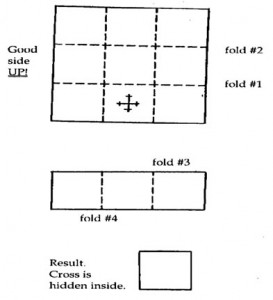
The Corporal is a linen square with a small cross embroidered on the center front. It is the cloth upon which the Chalice is placed. The corporal is either placed on the center of the Altar before the service or, if a burse is used, it is put in the burse to be placed on the altar by the priest. If making this linen, the hem should be very narrow and the corners mitered and the small cross should be embroidered on the front center. The Corporal also represents one of our Lord’s burial cloths.
The corporal is folded good side up, three folds lengthwise and three folds crosswise. Folded in this manner, the embroidered cross will not be visible until the Corporal is opened on the Altar.
The Lavabo Towel

The Lavabo towel or Mundatory is the towel for the Priest’s Lavabo. It should be 12 by 18 inches and made with a narrow hem on all sides. It is embroidered with a small cross or lily lengthwise on the front center. The Baptismal towel is the same size as the Lavabo towel, but may have a scallop shaped shell embroidered on it. Both towels are folded alike as shown to the left.
The Purificator
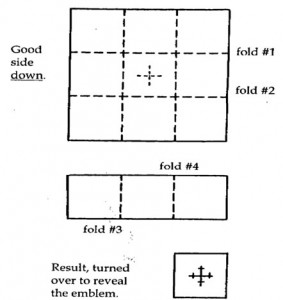
The Purificator is usually a 12 inch square linen which is used to wipe the lip of the chalice during the Eucharist. If making a purificator, its width and length should be 3 times the diameter of the chalice and the hem should be very narrow; a white 1 inch cross should be embroidered in the exact center of this linen. The purificator is folded in thirds and the cross in the center third is draped across the chalice during its vesting.
The Chalice Pall
The Chalice Pall, which covers the paten, is a white linen square “envelope” into which a plexiglas square is placed. The open end of the linen has a flap to whipstitch or tuck in. The pall should be large enough to completely cover the paten. Usually a 7 or 8 inch square is sufficient. The pall may be embroidered with a cross or other symbol which is centered on one side. The entire pall and lining may be washed and, if dried in the sun, the linen pall will tighten and dry smoothly around the plexiglas square. Cardboard may also be used, but it must be removed for laundering.
The Chalice Veil and Burse
The Chalice Veil and Burse, if used, are usually made of silk or satin in the color of the season and may be quite elaborate. However, simple linen may be substituted as needed. The chalice veil is an 18 to 24 inch square which is placed over the vested chalice; it must be large enough to touch the altar on all sides. The burse is a hinged case, made of two 9 inch squares of silk with plexiglas inserts; it is placed on top of the chalice veil and may contain the corporal, the purificators, and the post communion veil. Due to their intricacy, the chalice veil and burse are often purchased.
The Post Communion Veil
The Post Communion Veil, if used, is of thin light weight linen, 18 to 24 inches square, which is placed over consecrated elements remaining after communion.
The Credence Cover
The Credence Cover or Cloth is a white cloth which covers the Credence table or shelf and hangs over the top a few inches. It may be plain or embroidered with a small cross in the center front. It may be trimmed in lace.
The Cere Cloth
The Cere Cloth is a waxed coated cloth that is used over a stone altar to protect the altar and to keep moisture from damaging the fair linen.
The Underlinen
The Underlinen , a plain linen, is placed directly on top of the altar and is the exact size of the altar top. The fair linen goes on top of the underlinen.
The Frontal
The Frontal is the ornamental silk cloth covering the front of the Altar and hanging to the floor. It may be attached to the protector. Its color should be changed with the liturgical season.
The Superfrontal
The Superfrontal is a short silk ornamental cloth covering the front of the altar, hanging about 8 inches from the top of the altar. It may be used over the frontal or by itself. Its color should be changed with the liturgical season.
The Protector
The Protector is a good quality cloth to cover the fair linen between services to protect it. It usually fits the top of the altar and may be a seasonal, natural, or white color. A cross or crosses may be embroidered on the protector.
The Pulpit
The Pulpit or Lectern Fall is a hanging in seasonal color which is hung, usually by hooks, from the front of the lectern and/or pulpit.
The Funeral Pall
The Funeral Pall is a vestment or hanging for a casket. All caskets in a parish are vested with the same pall or with an American flag for a member of the armed forces. The pall should be made large enough to cover the casket entirely. Palls used to be black, but most are white now, symbolic of the resurrection, and can be simple or ornate, often with one large cross covering the pall. To vest a container of ashes, the white silk chalice veil may be used.
—
All about the Sacred Vessels
When selecting Eucharistic vessels, precious metals such as silver and gold have been the standard historically. Simple sterling silver is always appropriate, lovely and will last forever if cared for properly. Many churches receive gifts of sacred vessels, often from parishioners in memory of or in honor of loved ones, priests or bishops, etc.
Alternatively, silver plate, glass, or pottery vessels are also appropriate for use at the Lord’s Table. Altar vessels generally are not made of brass.
One thing to remember when working with the sacred vessels is that metal should never touch metal and the chalice never touches metal or wood. Always use altar linen in between and underneath. For example, a purificator is always placed over the Chalice BEFORE the paten is placed on the chalice.
For new missions with few resources, for churches recovering from natural disasters, or for churches forced to reestablish their communion vessels “from scratch,” a silver plate, clear glass, or pottery goblet may become a chalice. A silver plate, clear glass, or pottery bread and butter plate or salad plate may be used as a paten.
The lavabo, flagon, breadbox or ciborium may be of silver or gold, but also may be of silver plate, clear glass or pottery. In emergency situations, a small clear glass bowl with a secure lid can serve as a breadbox. The lavabo is a bowl the priest fills with water for ceremonial washing of his fingers. The flagon is an extra pitcher for wine. It is larger than the cruet. The breadbox and ciborium contain the wafers or bread for Holy Communion.
The pair of cruets may be either crystal or clear glass. One cruet contains water and one cruet contains wine. Often each cruet has a stopper with a cross on top of it. Glass salad dressing cruets may be substituted as economical alternatives.
—
Clergy Vestments
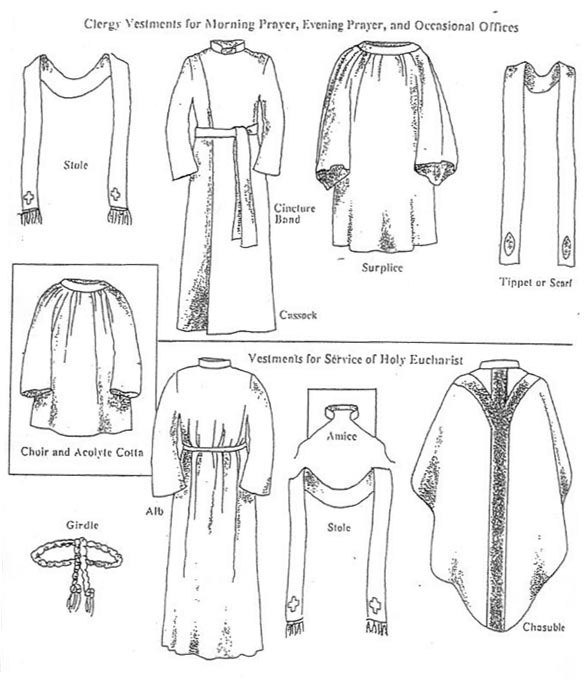
Priest’s Vestments
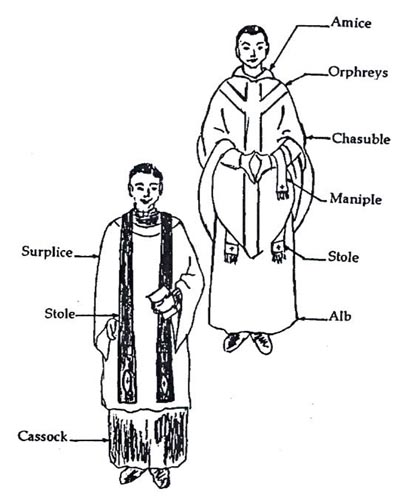
Bishop’s Vestments

—
Candles
Candles on the Altar may be either Eucharistic candles which are lighted for the Eucharist solely, or they may be Altar candles which are lighted during any service
Two Altar or Eucharistic candles are usually on the Altar Table, placed on opposite sides of the vested chalice, see photograph on page 7. However Altar candles also may be tall free standing candles, such as pavement candles, on either side of the altar.
If you are in temporary quarters, consider postponing the purchase of expensive altar candles; the size and dimensions needed in your permanent space may be very different than in your temporary space.
There is a great deal of variation in the style and appearance of candles and their holders among churches. The holders may be made of any material. The styles and sizes of candles really depend on what works in your worship space.
Most altar guilds are responsible for the care and maintenance of the candles, making certain that they are ready for the next service. To avoid smoking or flame flaring candles, bees wax candles and their wicks must be trimmed frequently. Pure bees wax candles are the slowest burning, longest lasting.
Liquid wax candles look like bees wax candles but their care is different. Each brand is different, so read the care and maintenance instructions carefully.
Tapered candles are not used in the church.
Good things to have are candle burners or followers, which are caps that fit over the tops of candles and catch wax. These caps are usually made of glass or brass.
Other types of church candles include:
Other Types of Church Candles
Candelabraand multiple branched candleholders may be used for special occasions if preferred.
Paschal candle: A large pure white candle, on a tall candlestick in the sanctuary; it symbolizes the risen Christ and is lighted at services from the Easter Vigil until Pentecost. It is placed at the foot of the chancel steps (or as closely as possible)and lighted for baptisms and for funerals when a body or ashes are present.
Advent wreath: Four candles, 3 purple and 1 rose, in a circle of greenery, one lighted each Sunday of Advent; the center white candle, known as the Christ candle, is lighted on Christmas Eve. The five candles are lighted until Epiphany. The greenery is often rosemary, holly, fir, mistletoe, cypress, laurel and ivy.
Sanctuary light: A candle, within a glass container, which burns near the aumbry when it contains consecrated bread and wine. The candle may be electric or battery operated.
—
Flowers
Simplicity is the key word for the use of flowers in the Anglican Church. Flowers and greenery are always fresh or dried. Usually two tasteful arrangements, with the liturgical season and color in mind, are sufficient in the sanctuary.
Flower arrangements for the services generally are placed on retable or on niches in the reredos behind the altar and not on the altar itself. The flowers should enhance the beauty of the sanctuary while blending into the background.
The arrangements should never be taller than or compete with the cross, and their design should be classic, massed, and big enough to be seen, but not too big.
Altar guild or flower guild members should handle and arrange the flowers in vases themselves. Florists or others should never be allowed in the sacristy or in the sanctuary.
Flowers and greenery should never be allowed to wilt and wither in the sanctuary. Before that happens, the flowers may be taken to the ill, the hospitalized, or the home bound. These flowers are given to the Glory of God and are not for personal use.
Weddings: Flowers arranged by the altar guild may be placed in their usual spots. Customs about allowing flowers on the pews vary from church to church, but florists must never enter the sanctuary. Sanctuary flowers never go to the reception.
Funerals: Flowers at funerals are not always used. However if flowers are requested or arrive at the church, alter guild members should arrange them in the church’s vases and place them in the customary locations. After the funeral, the flowers may go to the home of the bereaved family, or where the family desires.
—
Seasons and Liturgical Colors
The Church Calendar
- Advent, Christmas
- Epiphany
- Ash Wednesday
- Lent
- Holy week(Palm Sunday, Maundy Thursday, Good Friday, Holy Saturday)
- Easter
- Pentecost
- Trinity Sunday
- After Pentecost
- All Saints’ Day
**An ordo calendar is indispensable. See number 1 under Resources and Supplies.
Purple
Purple is the color of and Advent and Lent. It symbolizes penitence, sorrow, and also royalty
Advent, the four Sundays before Christmas Day and the Sunday on or nearest St. Andrew’s Day, 30 November. Candles and greens are appropriate during this season. The Advent wreath has 3 purple candles, one rose (Mary) candle, and a large white candle in the center, the Christ candle. A candle is lighted on the first Sunday; on each following Sunday, an additional candle is lighted. The rose candle is lighted the third Sunday. The Christ candle is lighted on Christmas Eve. The Advent wreath is covered with greens signifying the Holy Spirit: ivy, laurel, cypress, rosemary, holly, fir, and mistletoe
Lent, includes 40 days, excluding Sundays which are often called little Easters. Lent extends from Ash Wednesday to Easter Eve. Purple is used from Ash Wednesday until Palm Sunday and the cross may be veiled in sheer purple.
White
White is the color of Christmas, Epiphany, The Baptism of our Lord, All Saints’ Day, Independence Day, Thanksgiving Day, Easter, Transfiguration Day, Ascension Day, and Trinity Sunday. It symbolizes purity and new birth. White is used for weddings, baptisms, funerals and special occasions.
Christmas season begins on Christmas Eve and continues through the twelve days of Christmas until Epiphany, on January 6
Epiphany celebrates the arrival of the Magi on the 6th and it ends on Shrove Tuesday. The color changes from White to Green after the first Sunday of Epiphany.
Easter begins with the Easter Vigil. The Paschal candle is placed in the sanctuary through Pentecost Sunday.
Green
Green is the color of ordinary time, from Pentecost until Advent. Green symbolizes spring, life, growth in the Holy Spirit.
Red
Holy Week includes Palm Sunday, Maundy Thursday, Good Friday, and Holy Saturday. On Palm Sunday the color is changed to Red and remains Red through the Maundy Thursday service.
Red is used for Holy Week and Pentecost (Whitsunday), Confirmation, Ordination, and Feast Days. Red is indicative of the Holy Spirit and Martyrdom, the days of the martyred saints.
Black
On Good Friday the cross is veiled in sheer black and the altar is bare.
—
Early Symbols of Christianity
| SYMBOL | SIGNIFICANCE |
| ALPHA-OMEGA | eternally of Christ |
| ANCHOR | faith |
| BREAD AND WINE | eucharist–death of Christ |
| CHI-RHO | first two letters of “Christ” in Greek |
| CROSS | death of Christ |
| DOVE | Holy Spirit at baptism of Christ |
| FIRE | Holy Spirit on Day of Pentecost |
| FISH | initial letters of “Jesus Christ, God’s son, Savior” in Greek, spelling ICHTHUS, the Greek word for “fish”; feeding of 5000; “fishers of men” |
| LAMB | Christ’s self-sacrifice |
| SHEPHERD | Christ’s care for His people |
| SHIP | Church (Noah’s ark; cf. baptism) |
| VINE | Christ’s union with His people; wine of eucharist |
—
Liturgical space inside your Church

Narthex: An entry hall or vestibule of a church; it is separated from the nave.
Nave: The area of the church containing the pews where the parishioners sit.
Transept: The transverse arm of a cruciform church.
Chancel: This is the liturgical space containing the: pulpit, lectern, choir, and sanctuary. It is that area immediately in front of and three steps up above the nave. The pulpit is on the Gospel side and the lectern is on the epistle side of the chancel. The choir may sit between the nave and the altar. The sanctuary is that part of the church beyond the altar rail.
Altar: The High Altar (main altar) is the table where the Eucharistic celebration takes place. It is normally located in the east end of the church; the liturgy is supposed to be celebrated with the priest and the congregants facing east (ad orientem), the direction whence Jesus will come again
Sacristy: The room(s) usually behind or near the sanctuary where the sacred vessels, vestments, and other supplies are stored, prepared, and cleansed. It is the non-observed liturgical space where members of the altar guild do their work and where the priests and servers gather to prepare for services.
—
Setting up the Sacristy
The sacristy is the area behind or near the sanctuary where the priest is able to vest and where the altar guild does its work.
If at all possible, allow space for a priest’s private vesting room. The vesting room should contain a closet or wardrobe for vestments and should also contain a vesting table or chest of drawers. Traditionally the priest’s vestments were arranged on the vesting table in the order in which they were worn, with the chasuble on the bottom. Today the vestments seem to fare better on hangers in closets.
The altar guild workroom itself should contain:
- A piscina, ideally one which includes a faucet for rinsing the consecrated elements directly into the piscina
- A regular sink with hot and cold water
- Cabinets for folded linens, cabinets with rollers for large linens
- Space for the liturgical hangings, frontals, superfrontals
- Cabinets for cleaning supplies, i.e. laundry soaps, silver polish
- Cabinets for flower arranging supplies and vases
- A closet for the priest’s vestments
- A secure closet for the sacred vessels; the unopened communion wine may be stored on the floor of this closet as well
- An abundance of countertop work space, if at all possible.
- A desk containing organizational information: an inventory of all the linens and sacred vessels, a checkout and return list of linens being prepared by a member away from the church, an order list for supplies, a flower chart, and the altar guild instructions for each service as it should be prepared in your particular church.
—
Resources and Supplies
Ashby Company
C.M. Almy & Son, Inc.
The Sacco Company
J. Wippell & Company Ltd.
Gaspard
Andrew Lane Co.
Michigan Church Supply
King Richard’s Religious Antiques
—
Commonly Used Terms
Ablutions: Ceremonial cleansing of the chalice and paten by the celebrant after the Eucharist.
Acolyte: One who assists the priest.
Advent Wreath: Four candles arranged in a circle, one of which is lighted on the first Sunday in Advent, and one more on each of the following Sundays in Advent. A white candle, the Christ Candle, is placed in the center of the circle and lighted on Christmas Eve, and thereafter during the Christmas season. See page 24.
Alb: The long white robe which the priest wears for services of Holy Eucharist.
Alms Basin: An offering plate.
Altar: The Holy Table upon which the Holy Eucharist is celebrated.
Altar Bread: The wafers or bread used at the Eucharist.
Altar Rail: A railing in front of the altar that separates the chancel from the rest of the church.
Amice: A large oblong white neck piece worn by some priests with some albs.
Aumbry: The ‘wall cabinet’ in the sanctuary that contains consecrated bread and wine. Also referred to as a ‘tabernacle’.
Baptistry or Baptistery: The place where the font is located, usually near the entrance of the church.
Baptismal Towel: The long, narrow towel which the celebrant uses to ‘dry off’ the newly baptized. For baptisms we put out one baptismal towel for each person to be baptized.
Bible Markers: The silk hangings which decorate the lectern.
Bishop: The highest order of the sacred ministry in the Anglican Church; the head of the
Diocese, elected by the Diocese.
Bishop Coadjutor: A bishop elected and given jurisdiction to assist and later to succeed the diocesan Bishop.
Bishop Suffragan: A bishop elected to assist the diocesan bishop, but without jurisdiction or right of succession.
Bishop’s Chair: A special chair on the gospel side of the sanctuary, reserved for the diocesan bishop on his visitations.
Bread Boxes: the small, round, silver ‘boxes’ with lids which hold the wafers for the Eucharist.
Burse: A square flat case used to hold the corporal, the post communion veil, if used, and purificator. It is placed on the veiled chalice at the Eucharist.
Cassock: The long garment which the priest wears under a white surplice for services other than the Eucharist. On Good Friday black cassocks are worn without the surplice.
Celebration: The consecration and administration of the Holy Eucharist.
Censer: A vessel for burning incense; especially, a covered incense burner swung on chains in a religious ceremony. See also ‘thurible’.
Cere Cloth: The protective cloth which goes on the altar between the frontal and the fair linen. This protects the linen of the frontal and the altar from wine spills.
Chalice: The ‘goblet’ from which wine is served.
Chalice Veil: See Post-Communion Veil and Silk Chalice Veil.
Chancel: The area which contains the choir pews, the organ, the pulpit, the lectern, and the altar.
Chasuble: The ‘poncho-shaped’ garment which the celebrant wears for the Eucharist. On
Sundays the priest puts it on at the Offertory.
Chimere: A long garment with arm holes, but without sleeves. It is worn by a bishop over the rochet and may be either red or black.
Ciborium: A chalice like cup with a cover, used for the bread at the Eucharist. It may be used in place of the bread box.
Cincture: A wide flat cloth belt or girdle worn around the cassock.
Cope: A long, elaborate cloak of colored silk or brocade worn by a bishop or priest at festival occasions. It has a clasp at the neck called a morse.
Cotta: A white garment similar to a surplice, but shorter and without a cross on the front. Worn by choir and acolytes over the cassock.
Credence Table or Shelf: The shelf on the Epistle (pulpit) side of the Altar. This table holds the wine and wafers to be consecrated, the lavabo bowl, and the lavabo towel.
Credence Table Cover or Credence Cloth: The linen cover which is placed on the credence table before the table is ‘set’.
Crozier: A bishop’s pastoral staff.
Crucifer: The cross-bearer in a procession.
Crucifix: The cross with the figure of our Lord upon it.
Cruets: The small pitchers which hold wine and water. The cruet containing wine is always kept to the right side of the water. When the cruets are placed on the credence table, the handles are toward the wall if there is an acolyte to serve the priest, or toward the nave when the priest is alone.
Deacon: One of three holy orders of the ministry.
Dean: The chief of the clergy on the staff of a cathedral; also the head of a seminary.
Diocese: The see or jurisdiction of a bishop.
Dossal: A tapestry or curtain which hangs behind the altar.
Dust Cover: The linen cloth which covers the altar fair linen after the worship service is over. A dust cover is often of a coarser weave of linen than the fair linen. It is simply a dust cover, even though it may be embroidered with crosses, etc.
Elements: The bread, wine, and water which are used at the Eucharist.
Epistle Side: The right side of the chancel as one faces the altar.
Eucharist: The service of Holy Communion.
The pair of candlesticks which is on the altar. These candles are lit only and when the Eucharist is celebrated. These are the only candles that go on the altar.
Eucharistic Vessels: Any or all of the containers and ‘dishes’ used for the Eucharist.
Eucharistic Vestment: The special vestments often worn at a celebration of the Eucharist or Holy Communion: alb, amice, girdle, stole, chasuble, and maniple.
Ewer: The large pitcher which holds water for baptisms. When there is a baptism, the ewer is filled with hot water just before the service, and placed on a small table near the font.
Fair Linen: The large white linen cloth which covers the altar, on top of the cere cloth. It is the altar’s tablecloth.
Flagon: A vessel to hold wine for the Eucharist.
Followers: The brass ‘collars’ which fit the tops of the candles to protect against drafts.
Font: The basin where baptisms are performed.
Frontal: A full-length, colored hanging for the altar.
Girdle: A white cotton or linen rope worn about the waist over the alb. Black girdles are sometimes worn over the cassock.
Gospel Book: The book which contains all of the Gospel readings.
Gospel Side: The left side of the chancel as once faces the altar.
Hangings: All of the colored silk items that decorate the sanctuary and chancel.
Host Wafer or Priest’s Host: The large wafer which is held up and broken by the celebrant at the Eucharist.
Hymn Board: The wooden board on the wall of a church which lists the day of the church season and the hymns for the day.
IHS: The first three letters of the name of Jesus in Greek. Also the initial letters of Jesus hominem salvator, Latin for “Jesus the Savior of mankind”.
Lavabo Bowl: The small silver bowl which is used by the priest for the symbolic washing of hands before celebrating the Eucharist. It is placed on the credence table with the lavabo towel.
Lavabo Towel: The small linen towel on the credence table, next to the lavabo bowl, with which the priest dries his/her hands after the symbolic washing of hands before celebrating the Eucharist.
Lectern: The podium from which the lessons are read.
Lectionary or Text Book: The book which contains all the Sunday Bible readings for the year. Texts change from Year A to Year B to Year C beginning with the first Sunday in Advent.
Liturgical Colors: The appropriate color for the day according to the church calendar. It is the color of the hangings and the color of the priest’s vestments. The calendar on the wall of the sacristy has the days printed in the appropriate color. The basic seasonal colors are:
Advent-Purple or Blue
Christmas-White
Epiphany-Green
Lent-Purple
Easter-White
Pentecost-Red
Trinity Sunday-White
Sundays After Pentecost-Green
Litany Desk: The portable kneeling bench or prayer desk.
Maniple: A short band or scarf worn on the left arm of the celebrant at Holy Communion as part of the Eucharistic Vestments. Most priests no longer use a maniple.
Mensa: The top of the altar or Holy Table.
Missal: Now known in many churches as the Service Book. The altar service book, containing the services of the Holy Eucharist, the collects, epistles, and gospels.
Missal Stand or Service Book Stand: The stand or desk upon which the altar service book rests.
Mitre: A liturgical headdress worn by bishops on formal occasions.
Oblations: The bread and wine brought to the altar at the offertory.
Oblation Table: A table which holds the bread and wine, the ‘oblations’, which are to be brought forward by members of the congregation during the offertory.
Offertory: The bringing of oblations and alms to the altar.
Office: A service of the church, other than Holy Eucharist, such as Morning or Evening Prayer.
Office Candles or Office Lights: The candles behind the altar on the retable next to the cross in the sanctuary. These candles, which are lit for all services, are often on three unbranched candle holders on each side of the cross. Some churches use three or seven branched candelabra.
Ordination: The conferring of Holy Orders by a bishop.
Orphrey: An embroidered band on a chasuble or other vestment or hanging.
Pall: This word means ‘covering’. It refers to two quite different coverings:
1. A pall is the small, linen covered square of Plexiglas which we use to cover the paten and host wafer on a vested chalice.
2. The funeral pall is the large, embroidered silk covering which covers the casket for a funeral.
Paschal Candle: The large, decorated candle which is lit at the Easter Vigil and burns throughout the Easter season to Pentecost. The Paschal candle is also used at baptisms and funerals.
Paten: The silver plate from which the communion wafers are served.
Pectoral Cross: The large cross worn by ordained priests and bishops.
Piscina: A drain in the sacristy which goes directly to the ground instead of into the sewer system. It is used for the disposal of consecrated elements: wine in chalices, bread crumbs on paten, and wine rinsed from purificators.
Priest: The second of the three orders of the priesthood; one who has been ordained by a bishop to administer the Sacraments of the Church.
Protector: Another word for dust cover.
Pulpit Fall: The decorative silk rectangle which hangs from the pulpit.
Purificator: The small linen square which the priest or other minister uses to wipe the rim of the chalice; acts like a napkin.
Rector: A priest who is head of a parish.
Reserved Sacrament: Consecrated bread and wine, the Body and Blood of Christ, that has not been distributed to communicants in a service of Holy Eucharist, and is kept in an aumbry or tabernacle. A small amount of consecrated bread and wine is often reserved for use by the priest and lay ministers in visitations, or for the sick, dying, or other similar circumstances.
Retable: A shelf behind the altar, also called a gradine.
Rochet: A long white linen vestment with wide sleeves tied at the wrists, worn by a bishop under a chimere.
Rood: A cross or crucifix.
Sacristy: A room where preparations are made for the worship service, the Lord’s Kitchen. In addition to the Altar Guild sacristy where we work, there is often a priest’s sacristy where the priest and acolytes vest.
Sanctuary: The space inside the altar rail.
Sanctuary Light: A light, usually a candle but not necessarily so, in the sanctuary that is constantly lit whenever there is reserve sacrament present in the aumbry or tabernacle.
Service Book or Missal: The large ‘prayer book’ from which the priest reads the service at the altar.
Service Book Stand: See ‘Missal Stand’. The stand which holds the service book on the altar.
Silk Chalice Veil: A square covering of silk or brocade used to cover the chalice and paten before and after the Eucharist.
Stole: A long narrow band of silk worn over the shoulders of the clergy at the Eucharist. It is worn over the alb, and usually matches the color of the hangings.
Superfrontal or Frontlet: A short hanging for the front of the altar It may be used over a frontal or separately, and may be made of handsome lace or silk.
Surplice: A white vestment with full flowing sleeves. It is longer than a cotta and has a cross on the front. Worn with the stole, it is the standard clergy vesture for any of the church’s offices.
Thurible: A censer. A vessel for burning incense; especially a covered incense burner swung on chains in a religious ceremony.
Tippet: A black scarf, wider than a stole, worn about the neck, with ends hanging down the front. It is worn by the clergy at choir offices. Usually the diocesan shield and the shield of the priest’s seminary are on the ends of the tippet.
Vested Chalice: The chalice, covered by a purificator, paten and host wafer, ready to be used by the priest. A priest’s host is not placed on the paten when the host is being presented from the oblation table.
Vestments: The special garments worn by the priest and other ministers of the service.
Vicar: A priest in charge of a mission or chapel
Wafer: The unleavened bread used at the Eucharist.
